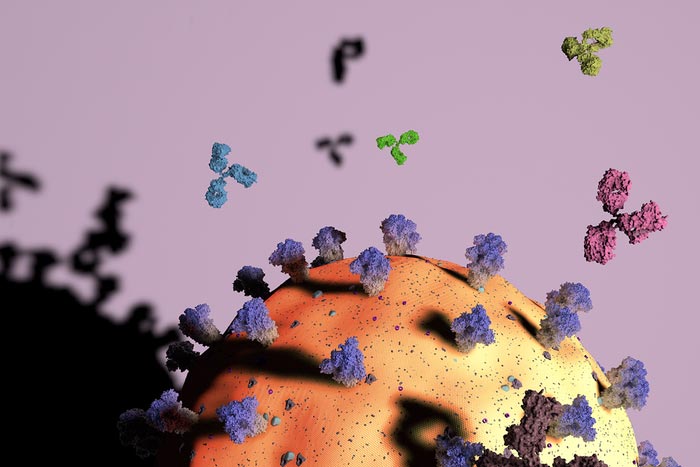Machine-learning model can distinguish antibody targets

Different antibodies (green, aqua, pink) attack different parts of the SARS-CoV-2 viral particle (yellow/orange sphere). The virus’s spike proteins (purple) are a key antibody target, with some antibodies attaching to the top (darker purple) and others to the stem (paler zone).
Graphic by Yiquan Wang
A new study shows that it is possible to use the genetic sequences of a person’s antibodies to predict what pathogens those antibodies will target. Reported in the journal Immunity, the new approach successfully differentiates between antibodies against influenza and those attacking SARS-CoV-2, the virus that causes COVID-19.
“Our research is in a very early stage, but this proof-of-concept study shows that we can use machine learning to connect the sequence of an antibody to its function,” said Nicholas Wu, a professor of biochemistry at the University of Illinois Urbana-Champaign who led the research with U. of I. biochemistry Ph.D. student Yiquan Wang; and Meng Yuan, a staff scientist at Scripps Research in La Jolla, California.
With enough data, scientists should be able to predict not only the virus an antibody will attack, but which features on the pathogen the antibody binds to, Wu said. For example, an antibody may attach to different parts of the spike protein on the SARS-CoV-2 virus. Knowing this will allow scientists to predict the strength of a person’s immune defense, as some targets of a pathogen are more vulnerable than others.
The new approach was made possible by the abundance of data related to antibodies against SARS-CoV-2, Wu said.
“In 20 years, scientists have discovered about 5,000 antibodies against the flu virus,” he said. “But in just two years, people have identified 8,000 antibodies for COVID. This provides an opportunity that’s never been seen before to study how antibodies work and to do this kind of prediction.”
The researchers used antibody data from 88 published studies and 13 patents. The datasets were big enough to allow the researchers to train their model to make predictions based on the antibodies’ genetic sequence.
The model was designed to distinguish whether the sequences coded for antibodies targeting regions on the influenza virus or on the SARS-CoV-2 virus. The researchers then checked the accuracy of those predictions.
“The accuracy was close to 85% overall,” Wang said.
“I was actually quite surprised that it worked so well,” Wu said.
The team is working to improve its model so that it can more precisely determine which parts of the virus the antibodies attack.
“If we can make these predictions based on antibody sequence, we might also be able to go back and design antibodies that bind to specific pathogens,” Wu said. “This is not something that we can do now, but those are some implications for future study.”
The National Institutes of Health supported this research.
Editor’s notes:
To reach Nicholas Wu, email nicwu@illinois.edu.
The paper “A large-scale systematic survey reveals recurring molecular features of public antibody responses to SARS-CoV-2” is available online and from the U. of I. News Bureau.
DOI: 10.1016/j.immuni.2022.03.019
Journal: Immunity
DOI: 10.1016/j.immuni.2022.03.019
Method of Research: Meta-analysis
Subject of Research: People
Article Title: A large-scale systematic survey reveals recurring molecular features of public antibody responses to SARS-CoV-2
Article Publication Date: 25-Mar-2022
COI Statement: No conflict of interest declared
Media Contact
Diana Yates
University of Illinois at Urbana-Champaign, News Bureau
diya@illinois.edu
Office: 217-333-5802
Original Source
All latest news from the category: Life Sciences and Chemistry
Articles and reports from the Life Sciences and chemistry area deal with applied and basic research into modern biology, chemistry and human medicine.
Valuable information can be found on a range of life sciences fields including bacteriology, biochemistry, bionics, bioinformatics, biophysics, biotechnology, genetics, geobotany, human biology, marine biology, microbiology, molecular biology, cellular biology, zoology, bioinorganic chemistry, microchemistry and environmental chemistry.
Newest articles

Innovative 3D printed scaffolds offer new hope for bone healing
Researchers at the Institute for Bioengineering of Catalonia have developed novel 3D printed PLA-CaP scaffolds that promote blood vessel formation, ensuring better healing and regeneration of bone tissue. Bone is…

The surprising role of gut infection in Alzheimer’s disease
ASU- and Banner Alzheimer’s Institute-led study implicates link between a common virus and the disease, which travels from the gut to the brain and may be a target for antiviral…

Molecular gardening: New enzymes discovered for protein modification pruning
How deubiquitinases USP53 and USP54 cleave long polyubiquitin chains and how the former is linked to liver disease in children. Deubiquitinases (DUBs) are enzymes used by cells to trim protein…



